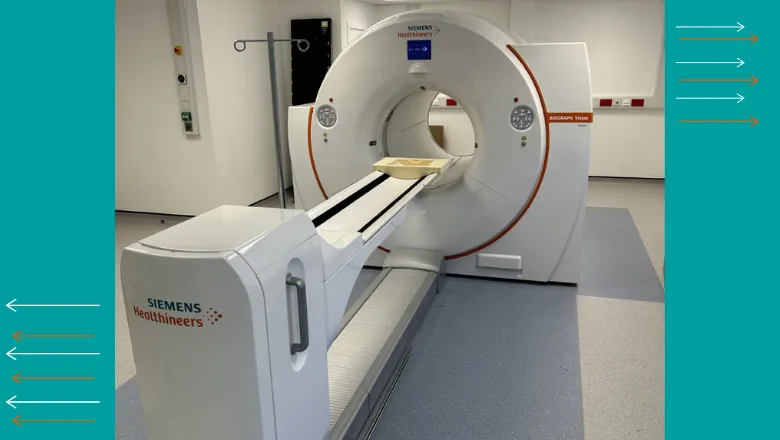The new long axis field of view PET/CT scanner awarded by the MRC (NPIP) allows us to acquire more accurate high quality research scan data, faster and with a lower radiation dose than before. This is the first of several trials that will take advantage of this state-of-the-art technology to improve cancer imaging research and ultimately better outcomes for cancer patients. Despite only being installed in November 2024, we have already scanned hundreds of patients who will benefit from more accurate diagnoses.
- Professor Gary Cook, Professor of PET Imaging, School of Biomedical Engineering & Imaging Sciences
28 March 2025
Groundbreaking Cancer Imaging Trial Begins Using Advanced PET Scanner
A pioneering clinical trial has begun to evaluate a new imaging tracer that could revolutionise cancer treatment monitoring.

Researchers at King’s College London (KCL) are using a cutting-edge imaging tracer, [18F]FSPG, to detect treatment responses in cancer patients earlier than existing imaging methods.
The trial led by Dr. Amy Sharkey, PhD student and Radiology registrar, and the primary investigator, Prof. Gary Cook, in close collaboration with Prof Tim Witney’s lab, is now underway and focuses on head and neck cancer and lung cancer patients. This translational study brings together expertise across the School of Biomedical Engineering and Imaging Sciences (BMEIS), encompassing the Cancer Imaging team and other experts at KCL’s School of BMEIS, including Prof Tim Witney’s lab who have led on the preclinical validation and GMP translation of [18F]FSPG. Together, they are working with leading oncology specialist collaborators from Guy’s & St Thomas’ Hospital’s, Dr Teresa Guerrero-Urbano and Dr Eleni Karapanagiotou to bring this study to fruition.
Typically, patients with cancer start a treatment plan – such as chemotherapy or radiotherapy – and then wait 3 months for a CT or PET scan to determine if the treatment has reduced the tumour, if the tumour has remained the same, or if it has grown. By using this technology, clinicians hope to be able to let patients know if treatment is working before 12 weeks and implement treatment changes if necessary.
Researchers from Prof Witney’s lab at King’s re-purposed the radiotracer, previously used as a diagnostic tool in clinical trials in the USA and South Korea, to show treatment-resistant tumours on PET scans. The molecule targets xCT, a tumour-associated protein present on therapy-resistant tumours.
The trial has begun, allowing the first research scans to be acquired on the Siemens Healthineers Quadra PET-CT scanner, recently installed at St Thomas Hospital. King’s is one of only two sites in the UK awarded centre grants by the MRC National Total-body Imaging Platform to house and operate the scanner.
The highly advanced scanner is at least ten times more sensitive than conventional PET scanners, allowing for faster scans—2-3 times quicker—while using less than half the standard radiation dose. This technology provides more accurate and higher-quality images, enhancing patient care and research outcomes.
This clinical trial represents a significant milestone for the world-class imaging research performed at King’s. By combining both state-of-the-art imaging technology with exciting new imaging tracers, such as [18F]FSPG, we are delivering on our remit to improve patient care. An early indicator of treatment resistance will enable the oncologists to adapt the therapy with the hope to improve patient survival. This has been a huge team effort over many years, but I’d like to especially thank Rizwan Farooq from my lab and Maggie Cooper, PET Chemistry Operations Manager, for producing this tracer ready for human injection – a big undertaking!
Professor Tim Witney, Professor of Molecular Imaging, School of Biomedical Engineering & Imaging Sciences
Patient recruitment is underway, with 32 participants expected to be scanned before and after receiving treatment. This trial marks a significant step toward improving cancer imaging and treatment monitoring, potentially benefiting thousands of future patients.





